
The president of the Republic of Korea, also known as the president of Korea, is both the head of state and head of government of the Republic of Korea. The president is directly elected by the citizens of the Republic of Korea and pledges to execute the duties of their office, chief among others "to defend the State, pursue peaceful unification of the homeland." The president leads the State Council, is the chief of the executive branch of the national government and the commander-in-chief of the Republic of Korea Armed Forces.
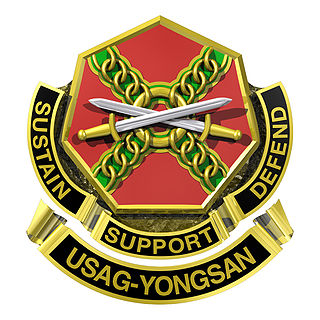
Yongsan Garrison, meaning "dragon hill garrison", is an area located in the Yongsan District of central Seoul, South Korea. The site served as the headquarters for U.S. military forces stationed in South Korea, known as United States Forces Korea (USFK), and as United States Army Garrison Yongsan (USAG-Yongsan) until 2018, under the supervision of the U.S. Army's Installation Management Command Pacific Region. From 1910 to 1945 it served as headquarters for the Imperial Japanese Army in Korea.
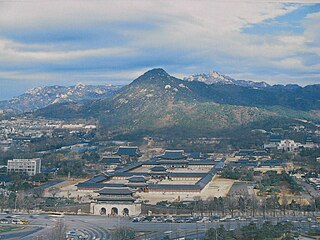
Gyeongbokgung, also known as Gyeongbok Palace or Gyeongbokgung Palace, was the main royal palace of the Joseon dynasty. Built in 1395, it is located in northern Seoul, South Korea. The largest of the Five Grand Palaces built by the Joseon dynasty, Gyeongbokgung served as the home of the royal family and the seat of government.
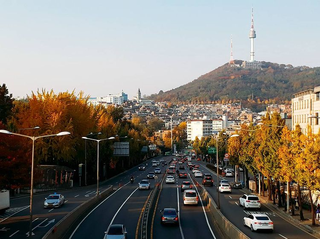
Yongsan District is one of the 25 districts of Seoul, South Korea.

Cheong Wa Dae, also known as the Blue House in English, is a public park that formerly served as the presidential residence and the diplomatic reception halls of the Republic of Korea from 1948 to 2022. It is located in the Jongno district of the South Korean capital city of Seoul, behind Gyeongbokgung Palace.

Itaewon is a commercial district in Seoul, South Korea, known for its nightlife and multi-ethnic population.

The government of South Korea is the national government of the Republic of Korea, created by the Constitution of South Korea as the executive, legislative and judicial authority of the republic. The president acts as the head of state and is the highest figure of executive authority in the country, followed by the prime minister and government ministers in decreasing order.
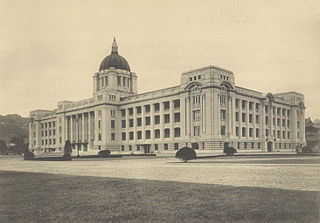
The Government-General of Chōsen Building, also known as the Japanese General Government Building and the Seoul Capitol, was a building located in Jongno District of Seoul, South Korea, from 1926 to 1996.

Diplomatic relations between South Korea and the United States commenced in 1949. The United States helped establish the modern state of South Korea, officially the Republic of Korea, and fought on its UN-sponsored side in the Korean War (1950–1953). During the subsequent decades, South Korea experienced tremendous economic, political and military growth.

Formerly a single nation that was annexed by Japan in 1910, the Korean Peninsula was divided into occupation zones since the end of World War II on 2 September 1945. The two sovereign countries were founded in the North and South of the peninsula in 1948, leading to the formal division. Despite the separation, both have claimed sovereignty over all of Korea in their constitutions and both have used the name "Korea" in English. The two countries engaged in the Korean War from 1950 to 1953 which ended in an armistice agreement but without a peace treaty. North Korea is a one-party state run by the Kim family. South Korea was formerly governed by a succession of military dictatorships, save for a brief one-year democratic period from 1960 to 1961, until thorough democratization in 1987, after which direct elections were held. Both nations claim the entire Korean Peninsula and outlying islands. Both nations joined the United Nations in 1991 and are recognized by most member states. Since the 1970s, both nations have held informal diplomatic dialogues in order to ease military tensions.

Jongno District is a district in Seoul, South Korea. It is the historic center of Seoul that contains Gyeongbokgung, the main royal palace of the Joseon dynasty, and the Blue House, the former presidential residence.

The National Assembly Proceeding Hall is a building in Yeouido-dong, Yeongdeungpo District, Seoul which serves as the location of the National Assembly of the Republic of Korea, the legislature of South Korea.

Moon Jae-in is a South Korean politician and former lawyer who served as the 12th president of South Korea from 2017 to 2022. Before his presidency, he served as Senior Secretary for Civil Affairs and Chief of Staff to President Roh Moo-hyun, Member of the National Assembly, and Leader of the Democratic Party of Korea.

Byun Hee-jae is a South Korean conservative political commentator. He is also one of the founder of conservative weekly newspaper name Mediawatch.
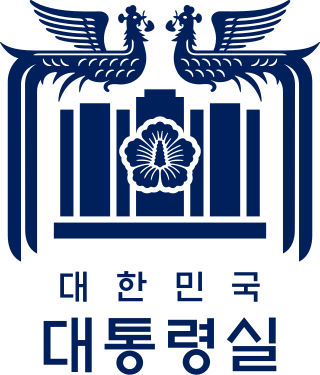
The Office of the President of the Republic of Korea assists the President of South Korea. Chief of Staff to the President is the head of the Office of the President and is a ministerial-level official. Cheong Wa Dae or Blue House was often used as a metonym for the Presidential Secretariat because of its location before President Yoon Suk Yeol moved the office and residency of the President out of Blue House in May 2022. The Presidential Secretariat is an important part of the executive branch of the South Korean government.

Yoon Suk Yeol is a South Korean politician and former prosecutor who has served as the 13th and current president of South Korea since 2022. Yoon was born in Seoul and earned two degrees from Seoul National University. In his capacity as chief of the Seoul Central District Prosecutor's Office, he played a key role in convicting former presidents Park Geun-hye and Lee Myung-bak of abuse of power. Then-president Moon Jae-in appointed Yoon prosecutor general of South Korea in 2019 from 2019 to 2021. During Yoon's leadership, the Supreme Prosecutor's Office conducted embattled investigations into Cho Kuk, an influential figure in the Moon administration, that led to Cho's resignation as minister of justice. Yoon's clashes with the Moon administration prior to his resignation as prosecutor general in March 2021 led to his rise as a potential presidential candidate among conservative voters.
The following lists events in the year 2023 in South Korea.
The following lists events in the year 2024 in South Korea.
The following is a list of events from the year 2024 in North Korea.
Beginning on 3 January 2025, South Korean authorities attempted to arrest the recently impeached President of South Korea Yoon Suk Yeol at his official presidential residence, which he had confined himself in since his impeachment on 14 December 2024. The arrest warrant, issued on 31 December 2024, stemmed from investigations into Yoon's martial law declaration on 3 December 2024, as well as his refusal to attend any of the three summons demanded by the Corruption Investigation Office for High-ranking Officials.
















